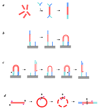Accurate whole human genome sequencing using reversible terminator chemistry
- PMID: 18987734
- PMCID: PMC2581791
- DOI: 10.1038/nature07517
Accurate whole human genome sequencing using reversible terminator chemistry
Abstract
DNA sequence information underpins genetic research, enabling discoveries of important biological or medical benefit. Sequencing projects have traditionally used long (400-800 base pair) reads, but the existence of reference sequences for the human and many other genomes makes it possible to develop new, fast approaches to re-sequencing, whereby shorter reads are compared to a reference to identify intraspecies genetic variation. Here we report an approach that generates several billion bases of accurate nucleotide sequence per experiment at low cost. Single molecules of DNA are attached to a flat surface, amplified in situ and used as templates for synthetic sequencing with fluorescent reversible terminator deoxyribonucleotides. Images of the surface are analysed to generate high-quality sequence. We demonstrate application of this approach to human genome sequencing on flow-sorted X chromosomes and then scale the approach to determine the genome sequence of a male Yoruba from Ibadan, Nigeria. We build an accurate consensus sequence from >30x average depth of paired 35-base reads. We characterize four million single-nucleotide polymorphisms and four hundred thousand structural variants, many of which were previously unknown. Our approach is effective for accurate, rapid and economical whole-genome re-sequencing and many other biomedical applications.
Figures







Comment in
-
Human genetics: Individual genomes diversify.Nature. 2008 Nov 6;456(7218):49-51. doi: 10.1038/456049a. Nature. 2008. PMID: 18987731 No abstract available.
Similar articles
-
The complete genome of an individual by massively parallel DNA sequencing.Nature. 2008 Apr 17;452(7189):872-6. doi: 10.1038/nature06884. Nature. 2008. PMID: 18421352
-
A map of human genome variation from population-scale sequencing.Nature. 2010 Oct 28;467(7319):1061-73. doi: 10.1038/nature09534. Nature. 2010. PMID: 20981092 Free PMC article.
-
Fast and accurate genomic analyses using genome graphs.Nat Genet. 2019 Feb;51(2):354-362. doi: 10.1038/s41588-018-0316-4. Epub 2019 Jan 14. Nat Genet. 2019. PMID: 30643257
-
Whole genome sequencing.Methods Mol Biol. 2010;628:215-26. doi: 10.1007/978-1-60327-367-1_12. Methods Mol Biol. 2010. PMID: 20238084 Review.
-
Whole-genome re-sequencing.Curr Opin Genet Dev. 2006 Dec;16(6):545-52. doi: 10.1016/j.gde.2006.10.009. Epub 2006 Oct 18. Curr Opin Genet Dev. 2006. PMID: 17055251 Review.
Cited by
-
The Evolution of Next-Generation Sequencing Technologies.Methods Mol Biol. 2025;2866:3-29. doi: 10.1007/978-1-0716-4192-7_1. Methods Mol Biol. 2025. PMID: 39546194 Review.
-
A mapping-free natural language processing-based technique for sequence search in nanopore long-reads.BMC Bioinformatics. 2024 Nov 13;25(1):354. doi: 10.1186/s12859-024-05980-7. BMC Bioinformatics. 2024. PMID: 39538122 Free PMC article.
-
Comparative Transcriptome Analysis of Cold Tolerance Mechanism in Honeybees (Apis mellifera sinisxinyuan).Insects. 2024 Oct 11;15(10):790. doi: 10.3390/insects15100790. Insects. 2024. PMID: 39452366 Free PMC article.
-
Avidity sequencing of whole genomes from retinal degeneration pedigrees identifies causal variants.PLoS One. 2024 Oct 4;19(10):e0307266. doi: 10.1371/journal.pone.0307266. eCollection 2024. PLoS One. 2024. PMID: 39365799 Free PMC article.
-
Telomere-to-telomere assemblies of cattle and sheep Y-chromosomes uncover divergent structure and gene content.Nat Commun. 2024 Sep 27;15(1):8277. doi: 10.1038/s41467-024-52384-5. Nat Commun. 2024. PMID: 39333471 Free PMC article.
References
-
- International Human Genome Sequencing Consortium. Finishing the euchromatic sequence of the human genome. Nature. 2004;431:931–945. - PubMed
-
- Shendure J, et al. Accurate multiplex polony sequencing of an evolved bacterial genome. Science. 2005;309:1728–1732. - PubMed
-
- Harris TD, et al. Single-molecule DNA sequencing of a viral genome. Science. 2008;320:106–109. - PubMed
Publication types
MeSH terms
Grants and funding
- Z01 HG200330-03/ImNIH/Intramural NIH HHS/United States
- WT_/Wellcome Trust/United Kingdom
- G0701805/MRC_/Medical Research Council/United Kingdom
- B05823/BB_/Biotechnology and Biological Sciences Research Council/United Kingdom
- MOL04534/BB_/Biotechnology and Biological Sciences Research Council/United Kingdom
LinkOut - more resources
Full Text Sources
Other Literature Sources
Research Materials


